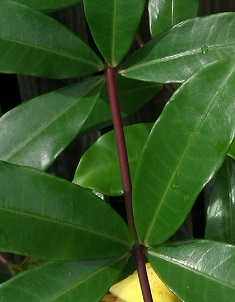Sharpen Your Powers Of Observation to Identify Plants

When you get used to looking at plants more closely, you will notice a greater variation than you used to between one type and the next. A big part of plant identification is to look at them closely and take notice of what you see. Start with the leaves.
A leaf is simply a structure that grows from a stem. The point at which a leaf is attached to the stem is called the node, and the space on a stem between two nodes is called the internode.
Where the leaf meets the stem, there is a bud, and this is part of the definition of a leaf. At a node you can usually find the bud, although sometimes buds are so small that they can't be seen by the naked eye. This bud is a growth point which can grow into a shoot with more leaves, a flowering shoot, a tendril, or even a thorn.
When an angiosperm seed germinates, the first leaves to be seen are called the cotyledons. Monocots (e.g. grasses) only produce one cotyledon. That is, when the first growth emerges from the seed it is only one leaf. Dicots (and eudicots), on the other hand, produce a pair of leaves when the seed germinates.
The first leaves which a plant has are not always the same shape and colour as the mature leaves. Many plants have what are called ‘juvenile foliage’. For example, many eucalypts have roundish blue leaves on a young plant but once mature the leaves become longer, less rounded and green-coloured with a distinct stalk (or petiole).
A normal leaf is made up of two main parts:
- Lamina – this is the leaf blade and is the flattened section which is the main part of the leaf.
- Petiole – this is the short stalk which attaches the leaf onto a stem.
The lamina is traversed by veins. The large vein in the centre of the lamina is called the midrib. Monocotyledons usually lack a midrib and show several parallel veins along the leaf.
Compound and Simple Leaves
Simple leaves consist of one distinct leaf blade, normally with a petiole. Compound leaves are made up of several smaller leaflets, which themselves look like small leaves. Leaflets can usually be distinguished because they lack axillary buds, flowers or shoots. These structures are only found in the true leaf axil of the entire leaf. Compound leaves are found in many families including: Fabaceae, Rosaceae and Apiaceae. However, it is sometimes difficult to decide whether you are looking at a compound leaf or a very highly divided simple leaf.
Leaf Shapes
The shapes of leaves are very variable between species and sometimes within species, but it is often impossible to see why they should be the shape that they are. Leaf shape does not appear to be under very strong evolutionary pressure in many species.
Learn More
Our Plant Taxonomy short course (launched June/July 2018) teaches you about every aspect of scientific plant identification. You learn to observe leaves more closely, and what to look out for in the leaf variations. You also learn to observe fruits, flowers and other parts of a plant; and how these various characteristics can be identifies and used to determine exactly what plant you are looking at.